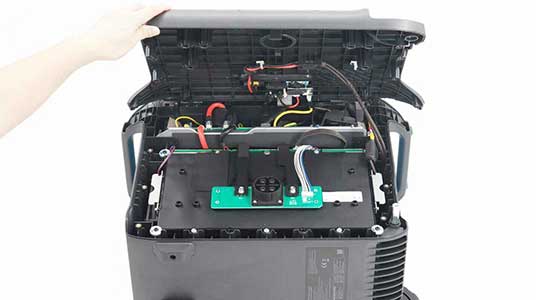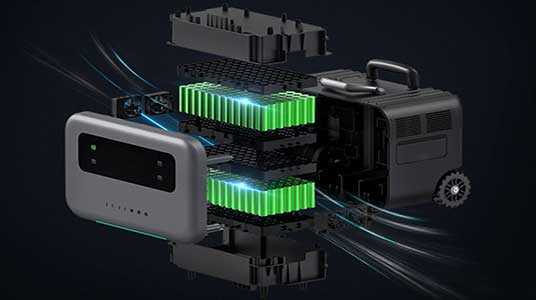Importance of knowing the lifespan of a portable power station

Knowing the lifespan of a portable power station is crucial for several reasons. It helps you plan and budget for future replacements, avoiding surprises with a dead battery. Secondly, it can help you choose the right type of power station based on your needs and expected usage frequency.
Understanding factors like battery type, usage, and maintenance maximizes device lifespan and long-term savings.
Factors that Affect the Lifespan of a Portable Power Station

Portable power stations are designed to provide portable and convenient power solutions for various outdoor and indoor activities. It’s vital to recognize that a portable power station isn’t limitless; it has a finite lifespan influenced by various factors. Being informed about these factors is crucial for optimizing your power station investment.
Battery type and quality
The battery is one of the most critical components of a portable power station. The type and quality of the battery used in a power station play a significant role in its lifespan. Lithium-ion batteries are popular in portable power stations due to their high energy density, lightweight nature, and extended cycle life. Nonetheless, variations in battery cell quality and construction among manufacturers can affect overall battery lifespan.
Usage frequency and pattern
The frequency and pattern of usage can also affect the lifespan of a portable power station. The more frequently a power station is used, the faster it will reach the end of its lifespan. Also, using a power station to power high energy-consuming devices, such as refrigerators or power tools, can significantly reduce its lifespan.
Operating conditions
The operating conditions of a portable power station can also impact its lifespan. Exposing a power station to extreme temperatures or humidity levels can cause damage to the battery and other components, shortening its lifespan. It’s essential to keep the power station in a dry and cool environment to prolong its lifespan.
Maintenance and storage
Proper maintenance and storage are essential to ensure the longevity of a portable power station. Regularly checking the battery health and ensuring it’s charged and discharged properly can prevent premature battery failure. Additionally, storing the power station in a dry and cool environment can prevent moisture damage and extend its lifespan.
Lifespan of Different Types of Portable Power Stations

When it comes to portable power stations, two types of batteries are commonly used: lithium-ion and lead-acid batteries. Each type has its own unique features and benefits, and also its own expected lifespan.
Lithium-ion battery
Lithium-ion batteries are popular in portable power stations due to their high energy density, low weight, and long cycle life. In general, a lithium-ion battery can last for around 500-1000 charge cycles, which translates to 2-5 years of use. However, the lifespan of a lithium-ion battery can be affected by several factors.
Factors that can shorten the lifespan of a lithium-ion battery include overcharging, exposure to high temperatures, and heavy usage.
Conversely, factors that can extend the lifespan include avoiding deep discharges, charging at moderate temperatures, and storing the battery in a cool, dry location.
Lead-acid battery
Lead-acid batteries are an older technology and are less commonly used in portable power stations. However, they are still popular due to their affordability and ability to deliver high currents. A lead-acid battery typically has a shorter lifespan, averaging 2-4 years, compared to a lithium-ion battery.
Factors that can shorten the lifespan of a lead-acid battery include overcharging, exposure to high temperatures, and repeated deep discharges.
Conversely, factors that can extend its lifespan include avoiding over-discharge, charging at moderate temperatures, and maintaining adequate water levels in the cells.
The power station’s lifespan depends on more than just battery type. Factors like usage, conditions, maintenance, and storage also affect longevity.
How to Maximize the Lifespan of Your Portable Power Station
Proper usage and maintenance are key factors in maximizing the lifespan of your portable power station. Here are some tips to help you get the most out of your device:
Read the user manual: Before using your portable power station, make sure to read the user manual carefully. This will help you understand how to use and maintain your device properly.
Avoid overcharging or over-discharging: Overcharging or over-discharging your battery can significantly reduce its lifespan. Make sure to follow the manufacturer’s recommended charging and discharging guidelines.
Use the right charger: Always use the charger that came with your portable power station or a charger recommended by the manufacturer. Using a third-party charger can damage your battery and reduce its lifespan.
Keep your device clean and dry: Keep your portable power station clean and dry to prevent dirt, dust, and moisture from damaging the device. Use a soft cloth to wipe down the exterior of the device.
Store your device properly: When storing your portable power station, make sure to keep it in a cool, dry place. Avoid storing it in direct sunlight or in extreme temperatures.
Charge and discharge regularly: Even if you’re not using your portable power station, it’s important to charge and discharge the battery regularly. This helps keep the battery healthy and can prolong its lifespan.
By following these tips, you can help maximize the lifespan of your portable power station and get the most out of your investment.
When to Replace Your Portable Power Station
Knowing when to replace your portable power station is just as important as understanding its lifespan. Ignoring signs of battery deterioration can lead to the power station failing unexpectedly, leaving you stranded without power.
The most common sign of battery deterioration is a decreased runtime or capacity. If your power station can no longer hold a charge for as long as it used to, it may be time to replace the battery. Another sign to look out for is a swollen or bloated battery, which can indicate internal damage and potential danger.
In addition to signs of battery deterioration, there are other factors to consider when deciding whether to replace your portable power station. If your power needs have increased and your current power station no longer meets them, it may be time to upgrade. Similarly, if your power station has become outdated and is no longer compatible with newer devices, it may be time to replace it.
It is also important to keep in mind the warranty of your portable power station. If your power station is still under warranty and is experiencing issues, you may be eligible for a repair or replacement. However, if the warranty has expired, it may be more cost-effective to simply replace the power station rather than repair it.
Ultimately, the decision to replace your portable power station will depend on a variety of factors, including its lifespan, signs of battery deterioration, and your current power needs. It is important to regularly monitor the condition of your power station and address any issues before they become major problems.
Final recommendations for maximizing the lifespan of your portable power station.
To summarize, here are some final recommendations for maximizing the lifespan of your portable power station:
Choose a high-quality portable power station with a durable battery and good warranty.
Use your portable power station in accordance with the manufacturer’s instructions, including proper charging, discharging, and storage.
Avoid overloading your portable power station and keep an eye on its temperature during use.
If you plan to store your portable power station for an extended period of time, charge it to at least 50% before storing and recharge it every few months.
Regularly check the condition of your portable power station’s battery and replace it as soon as you notice signs of deterioration, such as reduced capacity or slower charging times.
By following these recommendations, you can help ensure that your portable power station has a long and reliable lifespan, providing you with power when you need it for years to come.
